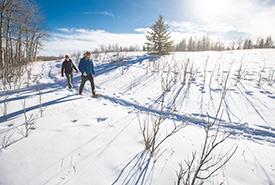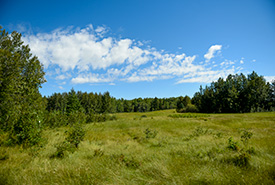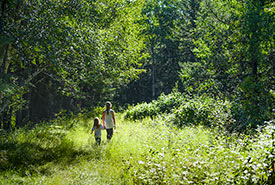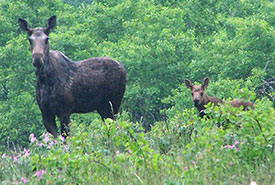From the ground up: How Bunchberry Meadows came to be a place for nature exploration

A winter hike on the Bunchberry Meadows property (Photo by Brent Calver)
Just outside of one of Canada’s busiest cities lies an outdoor adventure waiting to be had, with trees as tall as the eye can see.
Located just 30 kilometres from downtown Edmonton, the Nature Conservancy of Canada’s (NCC’s) Bunchberry Meadows provides city dwellers with a quick escape out of the busy metropolis and into nature.
“When I was first given a tour of Bunchberry Meadows by NCC staff, I was in complete amazement that a landscape so beautiful and diverse could exist so close to the city,” says Natalie Goulet-Sorenson, landscape architect at Stantec.
As Edmonton grew and changed, Bunchberry Meadows remained the same — maintaining some of the only true old-growth forests in Alberta. As the city continues to develop, it has become increasingly difficult for urbanites to find open, natural spaces to enjoy, or in which to teach their children about the outdoors.
In 1974, five families bought the Bunchberry Meadows Conservation Area, near the Devonian Botanic Garden. For 40 years the families cared for the land, protecting important habitat for moose and numerous other species.
When they decided to sell the land, the family members approached NCC.
Related blog posts

Bunchberry Meadows, AB (Photo by NCC)
Natalie was part of the Stantec team that created a sustainable infrastructure so that the public can safely explore and enjoy Bunchberry Meadows.
“It was important to us that we incorporate as much recycled material as possible to support the natural history of the site,” recalls Natalie. “All the interpretive and directional signage posts are made from old, reclaimed fence posts that once surrounded the cattle yard.”
An important element Natalie and the team worked hard to minimize was the amount of disruption on the land while building infrastructure, such as trails.
“The parking lot was designed within the existing cattle yard, which had been previously cleared and disturbed,” says Natalie. “We worked with the existing grading as much as possible to not affect the drainage patterns of the surrounding tree stands.”
The team kept nature in mind while building infrastructure for the public to enjoy.

The Stantec team kept nature in mind while building infrastructure for the public to enjoy. (Photo by NCC)
“The trails were all established or upgraded within existing trail corridors so that the amount of disturbance for tree clearing was very minimal,” explains Natalie.
When she’s not working on building infrastructure for natural areas, Natalie and her family enjoy these outdoor green spaces.
“I find peace in hitting the trails for a hike or a run — mostly to relieve stress and stay fit, but also to reconnect with nature.”
While at Bunchberry, visitors may see some of the wildlife that this natural area shelters, including moose. The property’s jack pines, sand ridges, groundwater fens and wetlands teem with life.

Cow and calf moose (Photo by NCC)
“It’s important that Canadians take time to embrace and have a meaningful connection to nature,” says Natalie. “We wouldn’t be alive without nature.”
Bunchberry Meadows officially opened to the public in 2017. As one of NCC’s Nature Destinations, Bunchberry Meadows is the perfect getaway for nature lovers and those looking to dip their toes into the outdoors, without having to drive hours to do so.
“I fall increasingly in love with Bunchberry Meadows every time I visit,” says Natalie. “I’m so honoured to have been a part of such an important and special project. It’s wonderful that we have organizations like NCC to conserve and protect our landscapes.”


